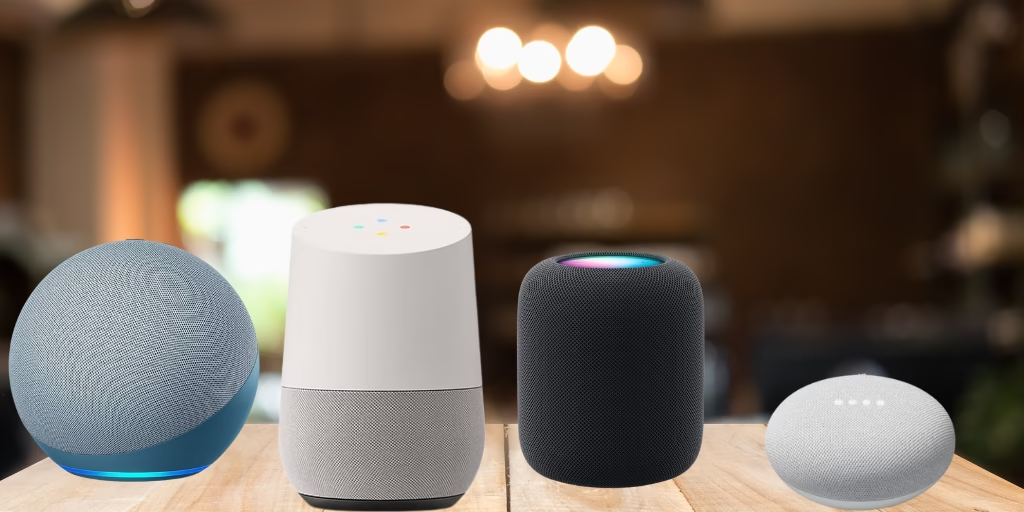How Alexa, Google Assistant & Apple Siri Connect Your Smart Home Devices
The modern home is transforming into a connected system where voice activated home assistants play a role. Amazon Alexa, Google Assistant, and Apple’s Siri (via HomeKit) can all link with smart devices, giving enabling remote access and automating routines.
Alexa is well known for its expansive Skills library and some Echo devices with built‑in smart home connectivity (such as integrated Bluetooth or Zigbee hubs), Google and Apple offer powerful integration through their respective platforms.
This article takes an in-depth look at how each system connects with smart home devices, programmes routines, and extends functionality through their apps and smart home features.
Amazon Alexa: Skills, Routines & Built‑in Connectivity
How Alexa Connects with Smart Devices
Amazon’s Alexa utilises a variety of wireless protocols including Wi‑Fi, Bluetooth and Zigbee. Most Alexa enabled devices can connect directly over Wi‑Fi, while some models such as the Echo 4 include a built‑in Zigbee hub that simplifies the connection of compatible smart bulbs, sensors, locks, and more. Alexa’s app uses built‑in Bluetooth for device discovery and setup in addition to maintaining a connection with your smart home.
The Power of Alexa Skills
Alexa Skills are voice activated apps that extend Alexa’s functionality. They enable users to integrate devices and services that might not directly communicate with Alexa. For example, a Philips Hue (smart light bulbs) Skill can create a bridge between your Philips Hue smart lighting system and Alexa. Once enabled, you can control your lights with simple voice commands. This approach is particularly useful when linking Alexa with smart home hubs that use connection protocols that the Echo doesn’t directly support.
Programming Routines with Alexa
Alexa allows you to create custom routines via the Alexa app. These routines chain together multiple actions into one voice command or based on a scheduled trigger. For instance, you can create a “Good Night” routine that turns off lights, lowers the thermostat, and locks the doors when you say “Alexa, good night.”
Alexa Integrations with Home Assistant
Home Assistant is widely recognised as the most powerful smart home platform available. Thankfully, there are several ways to link it with Alexa. Combining Home Assistant’s local control and automation with Alexa’s voice convenience gives you the best of both worlds. To find out more on integrating Home Assistant with Alexa take a look at Integrating Home Assistant with Amazon Alexa
Google Assistant: Control through Routines and Google Home App
Connecting Devices with Google Assistant
Google Assistant integrates with a wide range of smart devices (not as many as Alexa) using Wi‑Fi and sometimes Bluetooth. Through the Google Home app, devices such as smart speakers, thermostats, lighting systems, and security cameras can be grouped and controlled together. Although Google Assistant does not focus on a separate “skills” ecosystem, its third party integrations provide similar functionality by linking various devices under one central interface.
Customising Your Home with Google Routines
The Google Home app offers a routines feature that lets you automate multiple actions with a single command. For example, you can configure a “Leaving Home” routine that turns off the smart lights, adjusts the thermostat, and sends you notifications if any security devices are triggered. Using location based triggers and scheduled routines, Google Assistant adapts to your daily life by making your smart home more responsive and interactive.
Integration and Ecosystem Benefits
Google’s emphasised integration with its own services, such as Calendar and Maps, helps create context aware routines. This means that Google Assistant can adjust your smart home settings based on your day’s schedule or your current location, improving the personalisation of your home automations.
Apple HomeKit: Secure, Customisable Scenes with Siri
How HomeKit Integrates
Apple’s HomeKit is designed with a focus on security and privacy. Using the Home app on iOS devices, users can connect HomeKit compatible smart home devices and control them through Siri. HomeKit supports both Wi‑Fi and Bluetooth connectivity, allowing devices such as smart locks, thermostats, and lighting to communicate reliably. Additionally, the HomePod and Apple TV can act as home hubs to enable remote access and automations.
Creating Custom Scenes and Automations
HomeKit provides “Scenes,” which are similar to routines, allowing you to programme multiple devices to work together. For example, a “Good Morning” scene might open your blinds, start your coffee maker, adjust the thermostat and play your favourite morning playlist on your HomePod. Siri’s natural voice commands make it easy to run these scenes with simple phrases.
Security and Ease of Use
Given Apple’s commitment to privacy, HomeKit devices benefit from a more secure communication framework, with strict certification standards designed to ensure that only verified devices connect to your home network. This secure ecosystem appeals to users who prioritise data protection and already use Apple devices (iPhone, iPad etc)
Comparing Voice Assistants
- Amazon Alexa: Offers a very broad range of integrations via Alexa Skills and devices with built‑in connectivity features, such as Bluetooth and Zigbee hubs. This flexibility makes it ideal for users looking to mix and match different brands and protocols.
- Google Assistant: Focuses on seamless integration through the Google Home app and context aware routines. Its strength lies in leveraging Google’s ecosystem to provide smart control that’s personalised to your daily schedule and location.
- Apple HomeKit: Prioritises security and privacy while offering customisable scenes through the Home app and Siri. It works best for users who value secure, streamlined automation with a user friendly setup. This does mean not nearly as many smart devices are supported by Apple, compared to Amazon Alexa
Conclusion
By understanding the differences, you can select the platform that best suits your needs and design. For most situations, Amazon’s Echo devices with the Alexa voice assistant offer the best Smart Home solution.





